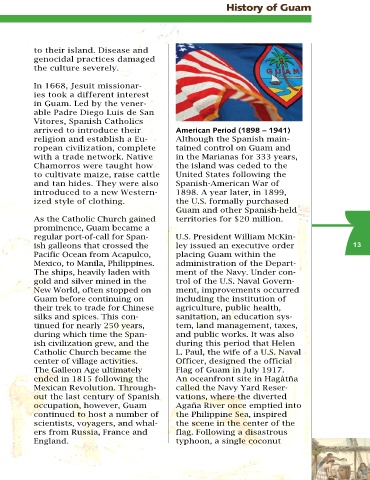Page 465 - Visitor Guides
P. 465
History of Guam History of Guam
tools, hunting artifacts, pot- arrival of Spanish explorer to their island. Disease and
tery, and drawings that have Ferdinand Magellan on March genocidal practices damaged
been left behind. Researchers 6, 1521, he is credited with the culture severely.
have further divided this era the island’s “discovery.”
into two periods – pre-latte Magellan, a native of Portugal In 1668, Jesuit missionar-
and latte. The designation is who was sailing on behalf of ies took a different interest
characterized by use of latte, the Spanish Crown, arrived in Guam. Led by the vener-
a limestone pillar (haligi) on Guam during his attempt able Padre Diego Luis de San
capped by a curved stone to circumnavigate the globe Vitores, Spanish Catholics
(tasa), that served as foun- from 1519-1522. arrived to introduce their American Period (1898 – 1941)
dation for homes and other religion and establish a Eu- Although the Spanish main-
buildings. Lattes can be found During his three-day stay, ropean civilization, complete tained control on Guam and
throughout the Marianas Magellan’s chronicler – Anto- with a trade network. Native in the Marianas for 333 years,
archipelago, on Guam and nio Pigafetta – documented Chamorros were taught how the island was ceded to the
on nearby islands including tales of thatched houses to cultivate maize, raise cattle United States following the
Saipan, Tinian and Rota. atop solid coral foundations and tan hides. They were also Spanish-American War of
(lattes). The crew went on to introduced to a new Western- 1898. A year later, in 1899,
Throughout both the pre-latte become the first to sail from ized style of clothing. the U.S. formally purchased
and latte periods, Chamorros the Atlantic to the Pacific Guam and other Spanish-held
were known as expert sea- Ocean, and the first to cross As the Catholic Church gained territories for $20 million.
men, fishermen, farmers, and the Pacific. prominence, Guam became a
artisans. Their “flying proa” regular port-of-call for Span- U.S. President William McKin-
12 – a lightning fast canoe used It wasn’t until three years ish galleons that crossed the ley issued an executive order 13
for trade within the Marianas later, in 1565, that Miguel Pacific Ocean from Acapulco, placing Guam within the
Islands – set them apart from Lopez de Legazpi officially Mexico, to Manila, Philippines. administration of the Depart-
other cultures. claimed Guam and its north- The ships, heavily laden with ment of the Navy. Under con-
ern islands for Spain. The gold and silver mined in the trol of the U.S. Naval Govern-
From the beginning, Guam Marianas Islands were named New World, often stopped on ment, improvements occurred
possessed a strong matriar- after Queen Mariana of Spain, Guam before continuing on including the institution of
chal society. The power and who funded Magellan’s jour- their trek to trade for Chinese agriculture, public health,
prestige of women enabled ney. silks and spices. This con- sanitation, an education sys-
much of the Chamorro cul- tinued for nearly 250 years, tem, land management, taxes,
ture, including the language, The Spanish Era, which didn’t during which time the Span- and public works. It was also
music, dance and traditions, reach its full potential until ish civilization grew, and the during this period that Helen
to survive. more than 100 years later, Catholic Church became the L. Paul, the wife of a U.S. Naval
had a tremendous political, center of village activities. Officer, designed the official
social, religious, and econom- The Galleon Age ultimately Flag of Guam in July 1917.
ic impact on the Chamorro ended in 1815 following the An oceanfront site in Hagåtña
culture. While several posi- Mexican Revolution. Through- called the Navy Yard Reser-
tive advancements including out the last century of Spanish vations, where the diverted
farming techniques and ani- occupation, however, Guam Agaña River once emptied into
The Spanish Era (1565 – 1898) mals (cattle) were introduced, continued to host a number of the Philippine Sea, inspired
Although many conquerors, the population also suffered scientists, voyagers, and whal- the scene in the center of the
merchants, and adventurers several setbacks from the ers from Russia, France and flag. Following a disastrous
landed on Guam prior to the introduction of a new culture England. typhoon, a single coconut

